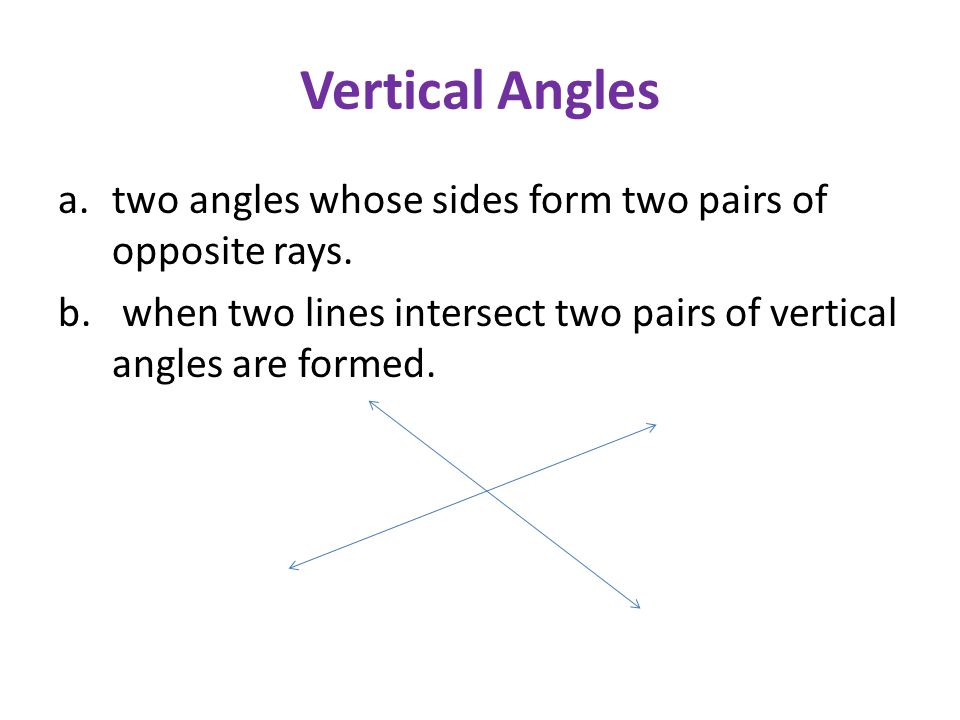Two Angles Whose Sides Form Two Pairs of Opposite Rays
A pair of adjacent angles whose non-common sides are opposite rays are called a linear pair. Two adjacent angles whose non-common sides are opposite rays.

Eoc Warm Up 2 Thursday September 4 Ppt Download
A quadrilateral with exactly two pairs of.

. Are two adjacent angles whose exterior sides are opposite rays always complementary. 16A Linear Pair is two adjacent angles whose non-common sides form opposite rays. The correct answer was given.
Two angles whose sides type two bag of the contrary rays. Two angles whose procedures sum to 90 degrees. So they must form a straight line --- supplemetary angles add up to 180 which is the case.
Together they equal 180. Vertical Angles are two angles whose sides form two pairs of opposite rays straight lines. If the transversal intersects two parallel lines then the angles are supplementary.
If two angles are vertical they their sides form two pairs of opposite rays. The measure of a straight angle is 180 degrees so a linear pair of angles must add up to 180 degrees. Vertical angles are located across from one another in the corners of the X formed by the two straight lines.
The answer would be Vertical Angles. They are located across from one another in the corners of the X formed by. Two angles whose procedures sum to 180 degrees.
If 2 angles form a linear pair climate they space. Two angles whose sides form two pairs of opposite rays or two non-adjacent angles formed by two intersecting lines if the sides of two angles form two pairs of opposite rays then they are vertical angles. Vertical angles are found where lines cross so meet the requirements of this description.
These are two angles who together form two pairs of opposite rays. The measure of a straight angle is 180 degrees so a linear pair of angles must add up to 180 degrees. A Linear Pair is two adjacent angles whose non-common sides form opposite rays.
Angles are not adjacent. Two coplanar angles with a common side a common vertex and no common interior points are called ____ angles. Click card to see definition.
Two angles whose sides form two pairs of opposite rays. The sides of one of a pair of vertical angles are rays opposite the rays that make up the sides of the other vertical angle in the pair. 1 and 2 form a linear pair.
A pair of adjacent angles whose non-common sides are opposite rays are called a linear pair. If two adjacent angles have their exterior sides in perpendicular lines then. If two angles are vertical angles then which of the following is not true.
----- sounds like adjacent angles to me. If two lines intersect then the vertically opposite angles are. Vertical Angles are two angles whose sides form two pairs of opposite rays straight lines.
They share a vertex but not a side. Two surrounding angles who noncommon sides are opposite rays. If two adjacent angles have their exterior sides in perpendicular lines then.
2 angles whose sides form two pairs of opposite rays straight lines. The line through points A B and C is a straight line. A pair of adjacent angles whose noncommon sides are opposite rays.
Formed by three or more line segments called sides. Two angles whose sides form two pairs of opposite rays. They are in the corners of the X formed by two straight lines across from each other.
Two angles whose sides are opposite rays are called _____ angles. Linear pair is two adjacent angles whose non common sides form opposite rays or Linear pair is two adjacent angles whose non common School Pasay City Science Highschool. If two angles are vertical angles then they are congruent.
17Vertical Angles are two angles whose sides form two pairs of opposite rays straight lines. A closed plane figure with the following properties. This means that these two angles form two lines.
What are two angles whose sides form two pairs of opposite rays. M1 m2 180. Sep 18 2015.
Tap card to see definition. Two angles whose sides form two pairs of opposite rays - Vertical Angles are congruent.

Identifying Angle Pair Relationships Ppt Download

Section 2 5 Proving Angles Congruent Ppt Download

Objectives A Identify Adjacent Vertical Complementary And Supplementary Angles B Find Measures Of Pairs Of Angles C Find The Co Ordinates Of The Ppt Download
No comments for "Two Angles Whose Sides Form Two Pairs of Opposite Rays"
Post a Comment